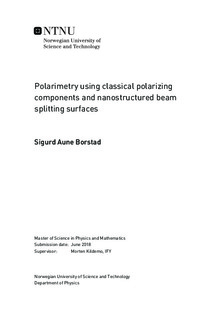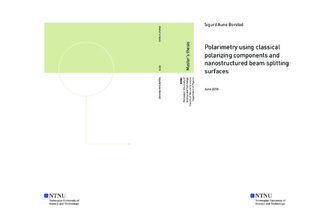| dc.description.abstract | Two methods for generation and analysis of the polarization state of light are studied
in this thesis. The first method is based on a traditional bulk design consisting of two
active components and 3 passive components in order to optimally generate 4 Stokes
vectors, and analyse one complete Stokes vector, respectively. The innovative step reported
in this thesis is the combination of a 600-1100 nm 2-Ferroelectric Liquid Crystal
(FLC) based system with a supercontinuum laser source tuned by an Acousto-Optic
Tunable Filter (AOTF). The system operates as a complete spectroscopic Mueller matrix
Ellipsometer for transmission measurements, using a single IngGaAs detector. It
shows highly promising results in the 700 to 930 nm range with a sub 2% Mueller matrix
element error. Equally good results in the 600 to 700 nm regime may also be possible.
The behaviour of the AOTF and the FLCs were studied in terms of switching speed
and stability. The source reached a stable state within 2 milliseconds after switching,
and was stable with a variation <.2% in the short time regime. The FLCs revealed a
tendency to drift a short time after switching, and a stable state was not reached until
0.2 seconds after switching was initiated.
The second method for generation and analysis of the polarization state of light is the
use of passive beam splitting metasurfaces. I outline the design and production steps for
beam splitting surfaces, and report the preliminary results for a manufactured Au/oxide/
Au thin film stack. Production involves the deposition of a multilayered film consisting
of two layers of Au with an intermediate layer of SiO2, and thin adhesive layers
of Ti. Characterisation of the films is performed using spectroscopic ellipsometry, Scanning
Electron Microscopy (SEM), Atomic Force Microscopy (AFM), and 3D Optical
Profilometry. Important properties such as deposition rate and the resulting surface
roughness have been determined, and satisfying optical models for each of the materials
and the multilayered film have been constructed. This forms a solid foundation for the
production of films which can later be nanostructured into beam splitting surfaces. | en |

